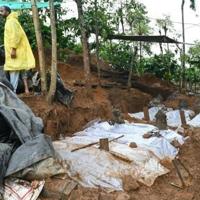Rescue teams in India are searching through mud-caked areas and villages following devastating landslides that have claimed the lives of around 200 people.
Heavy monsoon rains have caused havoc in the southern coastal state of Kerala, with blocked roads complicating relief efforts in the disaster zone in Wayanad district.
The frequency of fatal floods and landslides in India has been on the rise, a problem exacerbated by climate change according to experts.
Army teams are working tirelessly to construct a temporary bridge over swollen rivers to aid in the search and rescue operations, after resorting to makeshift methods like ziplines to move recovered bodies earlier.
Workers in the tea estates affected by the landslides have been struggling to cope with the loss of their loved ones, with many still missing. A laborer named Saraswathy expressed her despair at not being able to locate her sister and niece.
Wayanad district, known for its tea plantations, has been severely impacted by the disaster, with many lives lost as the mudslide swept through the brick-walled row houses where laborers and their families reside.
Authorities in Kerala have confirmed the recovery of at least 176 bodies from the disaster site, but the final death toll is expected to rise as more body parts are being discovered in the flood waters and mud.
– ‘High rainfall events’ –
The monsoon rains, essential for agriculture and water supply replenishment in the region, have been accompanied by record-breaking rainfall levels in recent years, resulting in more frequent and severe flooding incidents.
Damming, deforestation, and development projects in India have also contributed to the increased impact of natural disasters on human settlements.
India’s most deadly landslide in recent memory occurred in 1998, when heavy rains triggered rockfalls that buried the Himalayan village of Malpa, claiming the lives of at least 220 people.
ash/gle/pbt





